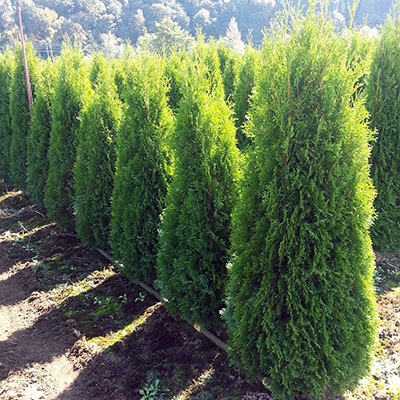 Fred Allebach is a member of the City of Sonoma’s Community Services and Environmental Commission, and an Advisory Committee member of the Sonoma Valley Groundwater Sustainability Agency. Fred is a member of Sonoma Overlook Trail Stewards, as well as Sonoma Valley Housing Group and Transition Sonoma Valley.
Fred Allebach is a member of the City of Sonoma’s Community Services and Environmental Commission, and an Advisory Committee member of the Sonoma Valley Groundwater Sustainability Agency. Fred is a member of Sonoma Overlook Trail Stewards, as well as Sonoma Valley Housing Group and Transition Sonoma Valley.
What is a true cedar?

Trees we commonly call cedars are actually members of the cypress family, Cupressaceae, including among others redwood, sequoia, incense cedar, cypress, juniper, arborvitae and cryptomeria.
True cedars are actually in the pine family, from the Genus Cedrus. Local examples of true cedars include the Atlas cedar (far east side of Plaza just north of tourist bureau sidewalk) and deodar cedar (just north of the Atlas cedar). True cedars are pine family; what we commonly call cedars are cypress family.
To further muddy the cedar water, a mahogany, Cedrela odorata is called cigar box cedar; the tamarisk is called saltcedar and Torreya taxifolia, in the yew family is called ‘stinking cedar’. Areas of cypress and juniper badlands are called cedar breaks or cedar roughs.
For the amateur naturalist, there’s plenty of room for cedar confusion. But that’s OK because the root meaning of amateur comes from the Latin amare, through the Spanish amar, to love. Amateurs love figuring this stuff out! Amateurs haven’t become jaded by professional restrictions. And this Latin connection to amar, (amor) and to love is not a Romance language characteristic in the simple sense. I digress.
Cypress family trees commonly referred to as cedar include: Western redcedar, Eastern white-cedar, Port Orford cedar, Atlantic white-cedar, Alaska cedar, Incense cedar, Japanese cedar and Eastern redcedar. In order to tell these and other cedars apart you have to know the characteristics of the following cypress family genera: Thuja, Chamaecyparis, Cupressus, Calocedrus, Cryptomeria and Juniperus. It takes time and effort to learn these differences and since these trees have many similarities it’s easy to just call them cedars. Keep in mind there is no formal classification of simply “cedars” in the cypress family.
Thuja or Northern white-cedar has over 300 cultivars and is planted locally, mostly as a yard hedge or street tree. These small trees have a yellow tinge to the foliage. Calocedrus or Incense cedar appears similar to sequoia but with flat, broad needle sprays. Just west of Newcomb on the Fryer Creek trail there’s a nice big Incense cedar. There are many local Cupressus, particularly Italian and Monterey cypress. See Watmaugh Road west of Broadway for a nice row of Monterey cypress. The tall, skinny ones are the Italian cypress ‘stricta’ variety. Italian cypress is also known as ‘graveyard cypress’, see the myth of Cyparissus. Hollywood juniper, a Chinese juniper cultivar, is fairly common in town, see a nice planting in front of the development on Blue Wing Drive, north side. Chamaecyparis lawsoniana or Port Orford cedar has many cultivars and is sold as a live Christmas tree at Sonoma Market. Cryptomeria or Japanese cedar is a rare exotic in Sonoma, and the one in the lower Mountain Cemetery has died. None of the above are native to the North Bay. The urban landscape has many introduced trees.
“Cedar” is a catch-all term for many different cypress family trees. There really is a fundamental similarity. This similarity is: general tree shape and branching pattern, vertical stringy bark texture, wood with a pleasant odor and many times, a flattened, segmented needle profile. When you hear people say “cedar” you are in all likelihood dealing with certain cypress family trees. A cedar chest is made from cypress family trees, not from Cedrus. Furthermore, within the false cedar category, cedar could refer to any number of typical Cupressacae or cypress family genera: juniper, cypress, arborvitae (Thuja), Port Orford cedar (Chamaecyparis) or Incense cedar (Calocedrus). Incense cedar is the wood pencils are made from.
A few final points of interest. Many cypress family trees are very tough and drought resistant. Junipers evolved in central Mexico, and have retained drought resistant characteristics such as vascular resistance to cavitation, or fatal air bubbles in the xylem. Some cypress species are specialized to live on serpentine soils, staking out ground few others can survive.
With quick, anthropogenic global warming impacting finely tuned tree adaptations, and with western states’ fire suppression and rangeland overgrazing, Western juniper and Utah juniper are displacing many pinyon pine ecosystems.
The diversity of California’s multiple ecosystems have provided the final refugia for many cypress family trees, such as redwood, sequoia, Monterey cypress, and many small cypress-proper species such as Tecate cypress, Macnab cypress, Gowen cypress, and Piute cypress.
The true cedars, Cedrus, are pines, and are not even native to North America. All the “cedar” dimensions opened up here trace back to the cypress family.



